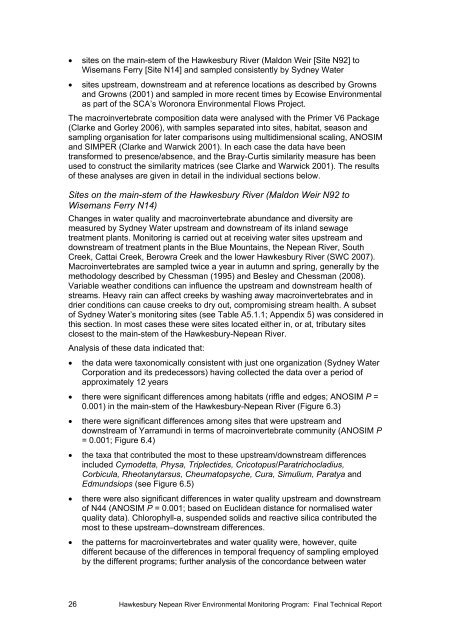Hawkesbury-Nepean River Environmental Monitoring Program
Hawkesbury-Nepean River Environmental Monitoring Program
Hawkesbury-Nepean River Environmental Monitoring Program
Create successful ePaper yourself
Turn your PDF publications into a flip-book with our unique Google optimized e-Paper software.
• sites on the main-stem of the <strong>Hawkesbury</strong> <strong>River</strong> (Maldon Weir [Site N92] to<br />
Wisemans Ferry [Site N14] and sampled consistently by Sydney Water<br />
• sites upstream, downstream and at reference locations as described by Growns<br />
and Growns (2001) and sampled in more recent times by Ecowise <strong>Environmental</strong><br />
as part of the SCA’s Woronora <strong>Environmental</strong> Flows Project.<br />
The macroinvertebrate composition data were analysed with the Primer V6 Package<br />
(Clarke and Gorley 2006), with samples separated into sites, habitat, season and<br />
sampling organisation for later comparisons using multidimensional scaling, ANOSIM<br />
and SIMPER (Clarke and Warwick 2001). In each case the data have been<br />
transformed to presence/absence, and the Bray-Curtis similarity measure has been<br />
used to construct the similarity matrices (see Clarke and Warwick 2001). The results<br />
of these analyses are given in detail in the individual sections below.<br />
Sites on the main-stem of the <strong>Hawkesbury</strong> <strong>River</strong> (Maldon Weir N92 to<br />
Wisemans Ferry N14)<br />
Changes in water quality and macroinvertebrate abundance and diversity are<br />
measured by Sydney Water upstream and downstream of its inland sewage<br />
treatment plants. <strong>Monitoring</strong> is carried out at receiving water sites upstream and<br />
downstream of treatment plants in the Blue Mountains, the <strong>Nepean</strong> <strong>River</strong>, South<br />
Creek, Cattai Creek, Berowra Creek and the lower <strong>Hawkesbury</strong> <strong>River</strong> (SWC 2007).<br />
Macroinvertebrates are sampled twice a year in autumn and spring, generally by the<br />
methodology described by Chessman (1995) and Besley and Chessman (2008).<br />
Variable weather conditions can influence the upstream and downstream health of<br />
streams. Heavy rain can affect creeks by washing away macroinvertebrates and in<br />
drier conditions can cause creeks to dry out, compromising stream health. A subset<br />
of Sydney Water’s monitoring sites (see Table A5.1.1; Appendix 5) was considered in<br />
this section. In most cases these were sites located either in, or at, tributary sites<br />
closest to the main-stem of the <strong>Hawkesbury</strong>-<strong>Nepean</strong> <strong>River</strong>.<br />
Analysis of these data indicated that:<br />
• the data were taxonomically consistent with just one organization (Sydney Water<br />
Corporation and its predecessors) having collected the data over a period of<br />
approximately 12 years<br />
• there were significant differences among habitats (riffle and edges; ANOSIM P =<br />
0.001) in the main-stem of the <strong>Hawkesbury</strong>-<strong>Nepean</strong> <strong>River</strong> (Figure 6.3)<br />
• there were significant differences among sites that were upstream and<br />
downstream of Yarramundi in terms of macroinvertebrate community (ANOSIM P<br />
= 0.001; Figure 6.4)<br />
• the taxa that contributed the most to these upstream/downstream differences<br />
included Cymodetta, Physa, Triplectides, Cricotopus/Paratrichocladius,<br />
Corbicula, Rheotanytarsus, Cheumatopsyche, Cura, Simulium, Paratya and<br />
Edmundsiops (see Figure 6.5)<br />
• there were also significant differences in water quality upstream and downstream<br />
of N44 (ANOSIM P = 0.001; based on Euclidean distance for normalised water<br />
quality data). Chlorophyll-a, suspended solids and reactive silica contributed the<br />
most to these upstream–downstream differences.<br />
• the patterns for macroinvertebrates and water quality were, however, quite<br />
different because of the differences in temporal frequency of sampling employed<br />
by the different programs; further analysis of the concordance between water<br />
26 <strong>Hawkesbury</strong> <strong>Nepean</strong> <strong>River</strong> <strong>Environmental</strong> <strong>Monitoring</strong> <strong>Program</strong>: Final Technical Report
















